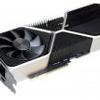Introduction
GeForce RTX 3080 Founder review
Brutal Shader and Raytracing power, but is 10GB VRAM enough?
We check out the GeForce RTX 3080 Founders edition graphics card. NVIDIA just unleashed this second-to-fastest model in the RTX 30 lineup, which promises to offer a truckload of performance paired with graphics eye-candy.
It was 2017 when the name Ampere as a GPU architecture surfaced on the web and, up-to earlier this year, NVIDIA had not listed this name in any of its roadmaps on the consumer side. It was with military-level secrecy that the Ampere consumer part was developed. Ampere, of course, is the base unit of electric current in the international system of units. But the GPU is named after André-Marie Ampère, a French mathematician and physicist, considered the father of electrodynamics. NVIDIA has a track record of naming their GPU architectures after mathematicians and physicists or figures from closely related fields, to name a few; Pascal, Fermi, Kepler, Maxwell and, more recently, Turing. While it was no secret that the new GPUs would be based on Ampere, we've seen much discussion about fabrication nodes, architecture and specifications. Still, everybody seems to have forgotten that Ampere already launched earlier this year for the HPC market. The very first product based on Ampere was the NVIDIA Tesla A100, outfitted with a GA100 Ampere GPU based on 7nm fabricated at TSMC; that product holds 54 billion transistors and has 6912 Shader cores.
On September 1st of the year 2020 NVIDIA announced three Ampere graphics cards in its initial launch wave. A week before announcements, specifications of the GeForce RTX 3080 and 3090 took a twist; the shader core count doubled up from what everybody expected. The GPUs are fabricated on an 8nm node derived from Samsung. This process is a further development of Samsung's 10nm process, no EUV is applied in production just yet. The first wave of announcements would see the GeForce RTX 3080 and 3090 being released first and, as a bit of a surprise, the GeForce RTX 3070 would be arriving in roughly the same timeframe as well. The initial launch of Ampere for consumers entails the GeForce RTX 3070 8GB GDDR6, RTX 3080 10GB GDDR6X, and a 24GB GDDR6X based flagship, the GeForce RTX 3090. The lineup brings Gen2 ray-tracing cores and 3rd iteration Tensor cores. These cards will all be PCIe 4.0 interface compatible and offer HDMI 2.1 and DisplayPort 1.4a.
The NVIDIA GA102 GPU empowering the GeForce RTX 3080 and 3090 graphics cards is one big GPU die alright, the 3090's GA102-300-A1 GPU is armed with 10496 Shader processors and 28 billion transistors. The GeForce RTX 3080 is listed as having 8704 Shader cores and the GeForce RTX 3070 (GA104) will bring 5888 Shader cores to the table. In this review, we'll check out the Founders edition GeForce RTX 3080, paired with 10GB of all new GDDR6X graphics memory.


